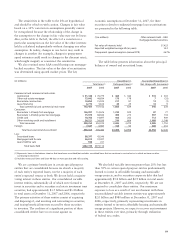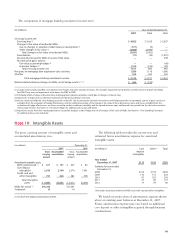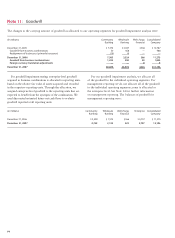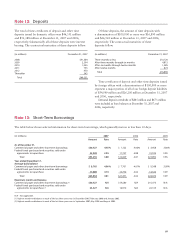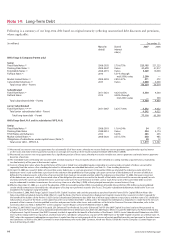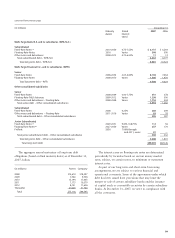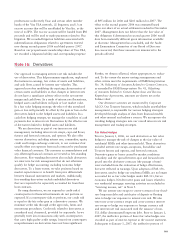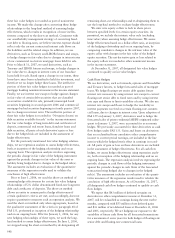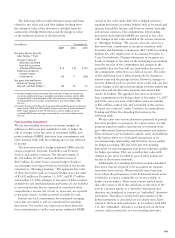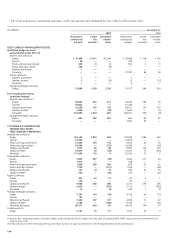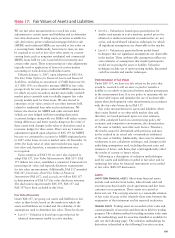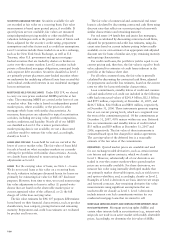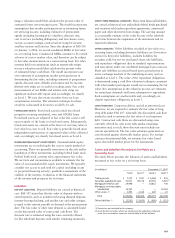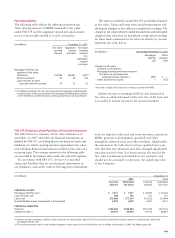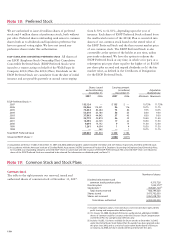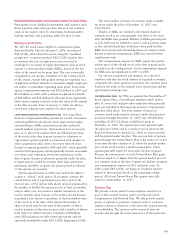Wells Fargo 2007 Annual Report Download - page 106
Download and view the complete annual report
Please find page 106 of the 2007 Wells Fargo annual report below. You can navigate through the pages in the report by either clicking on the pages listed below, or by using the keyword search tool below to find specific information within the annual report.
103
(in millions) December 31,
2007 2006 2005
Net gains (losses) from fair
value hedges (1) from:
Change in value of
derivatives excluded
from the assessment
of hedge effectiveness $8 $ (5) $ 350
Ineffective portion of
change in value
of derivatives 19 11 (399)
Net gains from ineffective
portion of change in the
value of cash flow hedges (2) 26 45 23
(1) Includes hedges of long-term debt and certificates of deposit, commercial
real estate and franchise loans, and debt and equity securities, and, for 2005,
residential MSRs. Upon adoption of FAS 156, derivatives used to hedge our
residential MSRs are no longer accounted for as fair value hedges under
FAS 133.
(2) Includes hedges of floating-rate long-term debt and floating-rate commercial
loans and, for 2006 and 2005, hedges of forecasted sales of prime residential
MHFS. Upon adoption of FAS 159, derivatives used to hedge our prime
residential MHFS were no longer accounted for as cash flow hedges under
FAS 133.
The following table provides derivative gains and losses
related to fair value and cash flow hedges resulting from
the change in value of the derivatives excluded from the
assessment of hedge effectiveness and the change in value
of the ineffective portion of the derivatives.
carried at fair value under FAS 159, is hedged with free-
standing derivatives (economic hedges) such as forwards and
options, Eurodollar futures, and Treasury futures, forwards
and options contracts. The commitments, free-standing
derivatives and residential MHFS are carried at fair value
with changes in fair value included in the income statement
in “Mortgage banking.” We record a zero fair value for a
derivative loan commitment at inception consistent with
Securities and Exchange Commission (SEC) Staff Accounting
Bulletin No. 105, Application of Accounting Principles to
Loan Commitments. Changes subsequent to inception are
based on changes in fair value of the underlying loan resulting
from the exercise of the commitment and changes in the
probability that the loan will not fund within the terms of
the commitment (referred to as a fall-out factor). The value
of the underlying loan is affected primarily by changes in
interest rates and the passage of time. However, changes in
investor demand, such as concerns about credit risk, can also
cause changes in the spread relationships between underlying
loan value and the derivative financial instruments that
cannot be hedged. The aggregate fair value of derivative
loan commitments in the balance sheet at December 31, 2007
and 2006, was a net asset of $6 million and a net liability
of $65 million, respectively, and is included in the caption
“Interest rate contracts” under Customer Accommodation,
Trading and Other Free-Standing Derivatives in the
following table.
We also enter into various derivatives primarily to provide
derivative products to customers. To a lesser extent, we take
positions based on market expectations or to benefit from
price differentials between financial instruments and markets.
These derivatives are not linked to specific assets and liabilities
in the balance sheet or to forecasted transactions in an
accounting hedge relationship and, therefore, do not qualify
for hedge accounting. We also enter into free-standing
derivatives for risk management that do not otherwise qualify
for hedge accounting. They are carried at fair value with
changes in fair value recorded as part of other noninterest
income in the income statement.
Additionally, free-standing derivatives include embedded
derivatives that are required to be accounted for separate
from their host contract. We periodically issue long-term
notes where the performance of the hybrid instrument notes
is linked to an equity, commodity or currency index, or
basket of such indices. These notes contain explicit terms
that affect some or all of the cash flows or the value of the
note in a manner similar to a derivative instrument and
therefore are considered to contain an “embedded” derivative
instrument. The indices on which the performance of the
hybrid instrument is calculated are not clearly and closely
related to the host debt instrument. In accordance with FAS
133, the “embedded” derivative is separated from the host
contract and accounted for as a free-standing derivative.
Free-Standing Derivatives
We use free-standing derivatives (economic hedges), in
addition to debt securities available for sale, to hedge the
risk of changes in the fair value of residential MSRs, new
prime residential MHFS, derivative loan commitments and
other interests held, with the resulting gain or loss reflected
in income.
The derivatives used to hedge residential MSRs include
swaps, swaptions, forwards, Eurodollar and Treasury
futures, and options contracts. Net derivative gains of
$1,154 million for 2007 and net derivative losses of
$145 million for 2006 from economic hedges related to
our mortgage servicing activities are included in the income
statement in “Mortgage banking.” The aggregate fair value
of these derivatives used as economic hedges was a net asset
of $1,652 million at December 31, 2007, and $157 million
at December 31, 2006. Changes in fair value of debt securities
available for sale (unrealized gains and losses) are not included
in servicing income, but are reported in cumulative other
comprehensive income (net of tax) or, upon sale, are reported
in net gains (losses) on debt securities available for sale.
Interest rate lock commitments for residential mortgage
loans that we intend to sell are considered free-standing
derivatives. Our interest rate exposure on these derivative
loan commitments, as well as new prime residential MHFS


